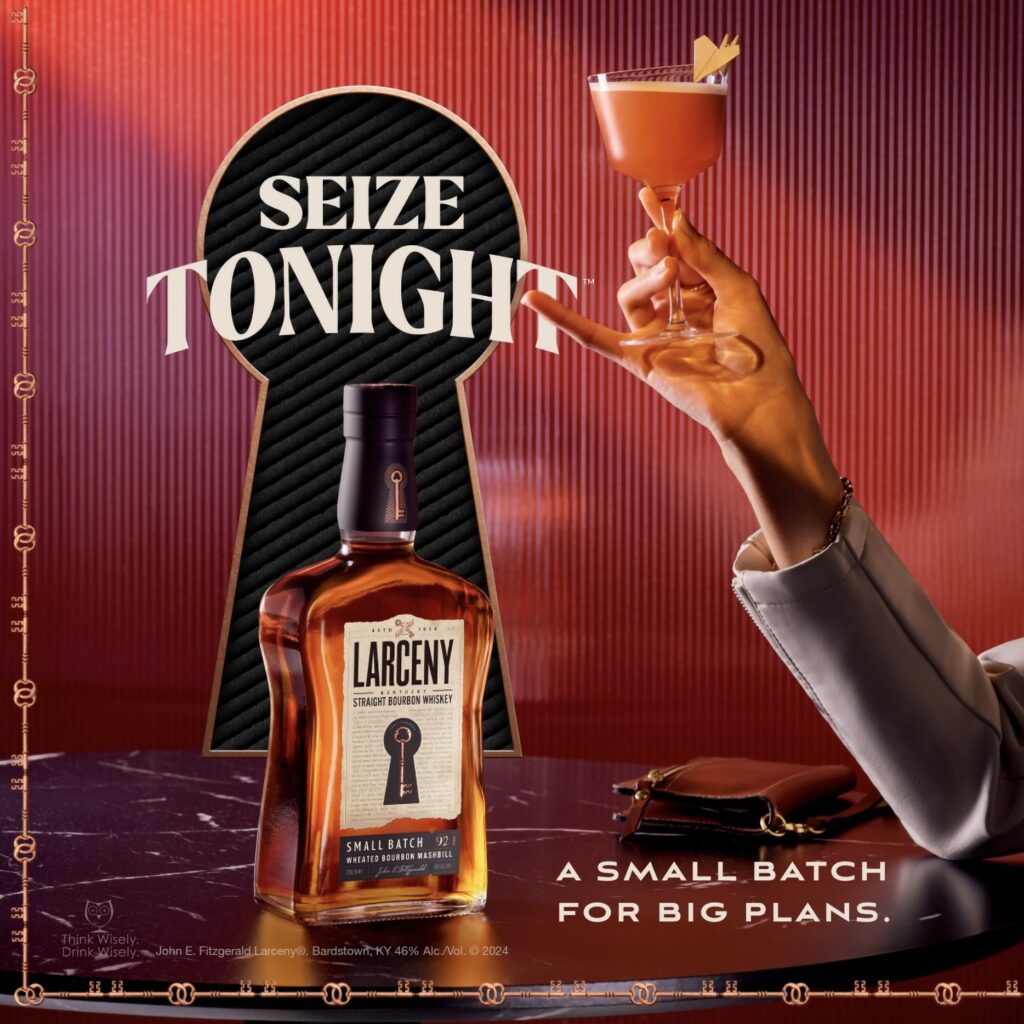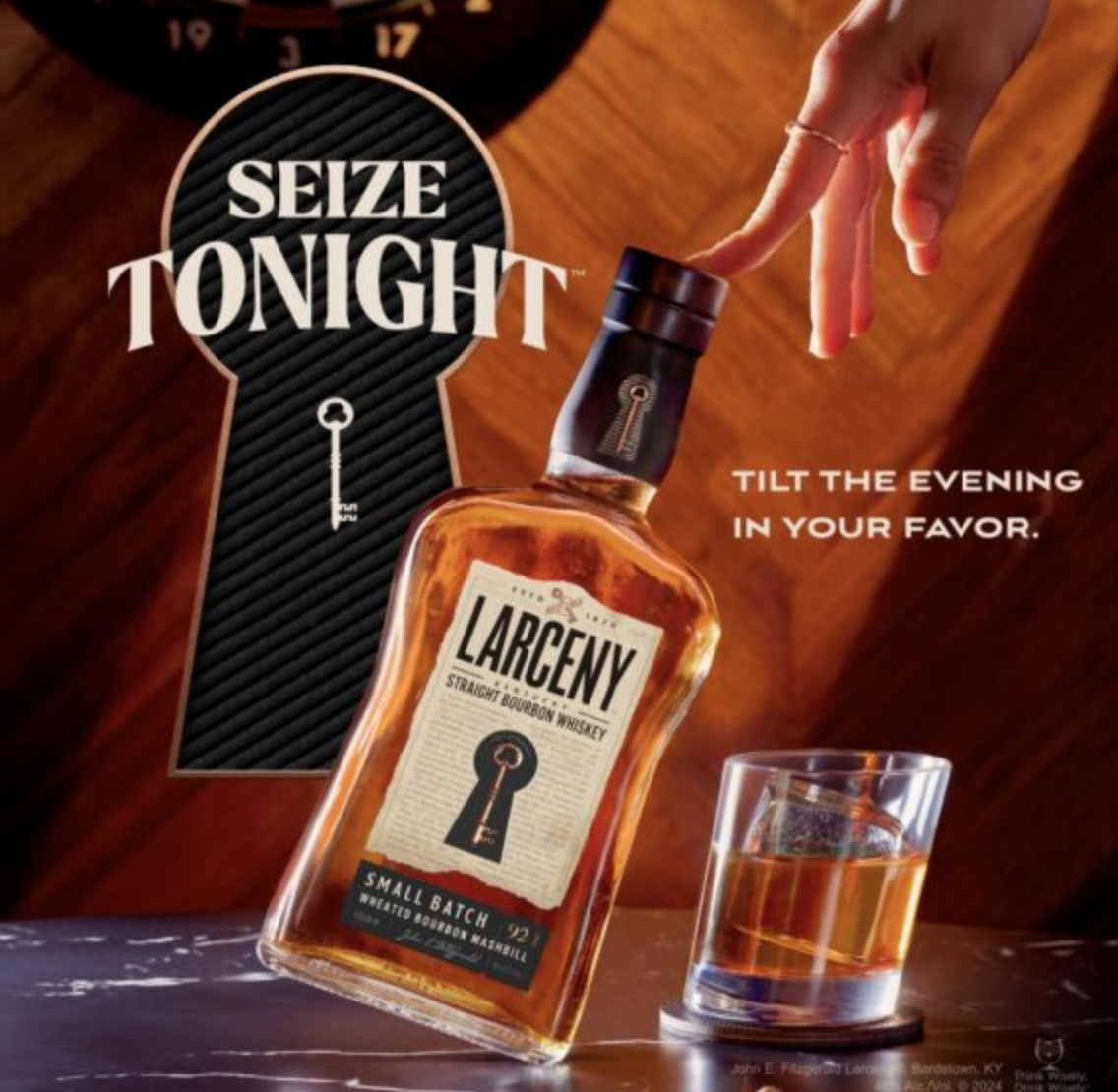Larceny Kentucky Straight Bourbon Whiskey Launches “Seize Tonight”
Larceny Kentucky Straight Bourbon Whiskey released an engaging new commercial to support the recently launched “Seize Tonight” which encourages fans of Larceny to unleash their carefree spirit and get into some “good mischief”.
The brand will also extend its reach with Community Ambassadors who embody this same spirit in the gaming, music and food scenes to create compelling content which highlights the craftsmanship behind Larceny Bourbon and their respective passions.

The “Seize Tonight” campaign is centered around the idea that the most memorable moments happen when you let curiosity get the best of you and take a little risk – much like John E. Fitzgerald himself.
On the heels of its successful premium packaging redesign, the brand will debut an engaging new ad on premium streaming platforms directed by award-winning commercial film director André Betz.
The spot shows how Larceny can be the catalyst for turning an ordinary evening into a memorable one.
The hero seizes the opportunity to liven his friends’ night out by playing the piano after seeing a compelling vision of a keyhole ignite on the instrument. The crowd is surprised to hear the piano play, partly because the hero is so good, but also because the piano is clearly off limits. The spot reaches a pivotal moment when the stern bartender walks over to tell off the hero, only to reveal that she’s there to pour him a glass of Larceny in appreciation of his spontaneity.
Both the 30-second video, as well as 15-second version, will be streamed on Connected TV and Online Video.
The “Seize Tonight” campaign’s manifesto will be brought to life by expanding the brand’s reach and appeal beyond the traditional bourbon drinker through influential Community Ambassadors in the gaming, music and food scenes.
LP Giobbi is a celebrated DJ, producer, pianist, and activist, known for her innovative sound and impactful contributions to music and advocacy.
BlackKrystel is a dominant force in in the world of gaming and has made her mark as an efficacious voice for carefree, authentic fun.
Fabrizio Villalpando is a no-holds-barred home cook whose bold attitude towards entertaining through food has left a mark in the culinary scene.
Justin Sajda is a self-described “average guy who makes above average cocktails” whose creative concoctions elevate the spirits he serves behind the bar and on social media where he can be found @thirstywhale_.
Unlike many other bourbons, Larceny is made with wheat instead of the traditional rye, using a mashbill of 68% corn, 20% wheat and 12% malted barley. The use of 20% wheat as the secondary flavor grain is 25% more than the leading competitor, resulting in exceptional smoothness. Larceny Small Batch is available nationwide at a SRP of $27.99 and the new, premium packaging is now shipping. Individual batches of Larceny Barrel Proof are released nationally on an allocated basis three times annually at a SRP of $64.99 and will be bottled in the new packaging starting this fall.
Fans of Larceny are encouraged to enjoy it straight, on the rocks or in the classic Paper Plane cocktail.
ABOUT LARCENY BOURBON
The story of Larceny begins with John E. Fitzgerald, a bonded U.S. Treasury agent with a penchant for thievery of the best Bourbon.
Using his keys to let himself into rickhouses at night, the “Fitzgerald Barrels”, as they came to be known, became one of America’s most beloved whiskeys after Prohibition with the launch of Old Fitzgerald.
Today, the John E. Fitzgerald story continues through Larceny, an incredibly smooth and exceptional small batch Wheated Bourbon. First brought to market in 2012, Larceny is one of the most successful new-to-the-world Bourbons in the past decade.
Produced by Heaven Hill Distillery, the brand offers Larceny Small Batch and Larceny Barrel Proof Kentucky Straight Bourbon Whiskey. Since its inception, Larceny has been an award-winning, best in class Bourbon receiving accolades such as Double Gold at the 2024 San Francisco World Spirits Competition and Whisky Advocate Whisky of the Year in 2020. F
or more information, please visit www.larcenybourbon.com.
Heaven Hill reminds you to “Think Wisely. Drink Wisely.”



